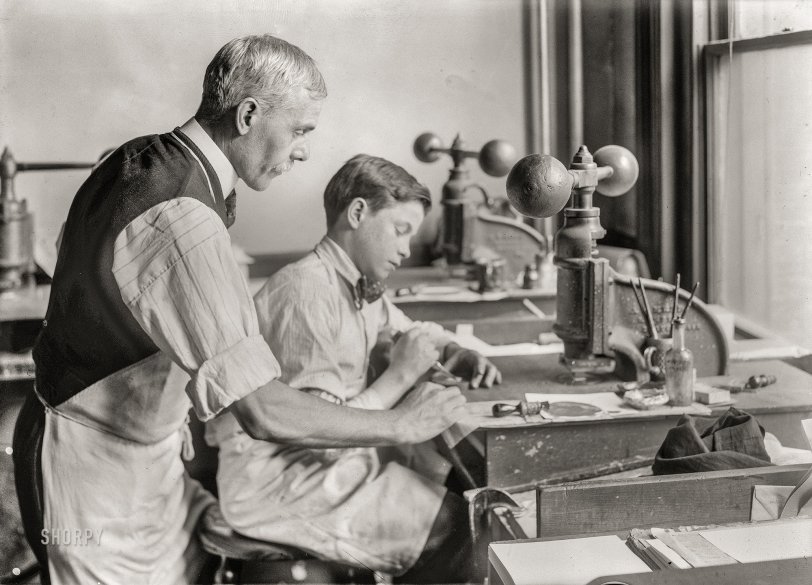


Framed or unframed, desk size to sofa size, printed by us in Arizona and Alabama since 2007. Explore now.
Shorpy is funded by you. Patreon contributors get an ad-free experience.
Learn more.

- Lofty addition
- In 1912
- Keenan Building
- Six years old
- Taken from the P.J. McArdle Roadway?
- It stood only 47 years
- Three track mind
- Incline to the right
- Reach for the sky, 1912 style
- No clean sweep
- Same Job Title, Same Face
- Sadly Lost
- Beautiful ...
- Where you get your kicks
- Aim High
- Pueblo Revival sisters
- Pueblo Neoclassicism
- Milk Man
- Regional dialect.
- Spielberg's inspiration
- Great Photo
- Loaf Story
- Do you still have the Rakes category?
- Could almost be a scene from the 1957 movie 'Hell Drivers'
- The Wages of Fear.
- Conspicuous by their absence
- Got Milk?
- All that aluminum
- No lefties
- Smoke 'em if you've got 'em
Print Emporium
The Apprentice: 1917

Jan. 30, 1917. "14-year old Fred cutting dies for a new job. Embossing shop of Harry C. Taylor. 61 Court Street, Boston, Mass." 5x7 inch glass negative by Lewis Wickes Hine. View full size.
Dress code
alexin just triggered a memory with the bow tie remark.
In olden times the dress code was quite immaculate.
Academics, engineers, medical staff, and some other professions: White lab coats, formal business attire underneath. I guess that was universial.
At least in German industry: Foremen frequently had grey "lab" or workshop coats. The line workers dressed in blue.
Exceptions confirmed the rule.
I also remember a TV interview with an ancient typesetter, way back when. His punchline: He chose to train as a typesetter because of the professions actually available to him this was the only one where he was to wear a tie and a white coat on the job, and where he would be addressed as "Mr. Schmidt" rather than by given name even as an apprentice.
The bow tie
is more than a fashion statement, it seems to me. By wearing a bow tie and nice shirt, Fred is showing that by training for a skilled artisan position, he is to be considered at a higher social standing than the common laborer, who would be wearing a "blue collar" shirt and work overalls. And the difference between Fred and a breaker boy is a massive chasm. I'm sure that Fred's family was proud that he got this apprenticeship, if he isn't actually related to the proprietor and learning the family business.
On a personal level, my own father was Fred's age in 1917 and his school teachers wanted him to be apprenticed to a solicitor (lawyer) to become a legal clerk. My grandfather objected though, probably because he was uncomfortable with the large jump in social standing for his son. At age 15, tired of selling winkles on the corner, he ran away from home, lied about his age and joined the British Army. By 1918, the British Army was more than well aware that underage boys were joining up, but desperate for manpower, they closed a blind eye to it. However, in order to avoid an outcry, they underage recruits were given jobs behind the lines, which freed up adults for the trenches. My father made a career out of it and by WWII was a regimental sergeant major supervising anti-aircraft batteries in the south of England.
Tool and Die Makers
I wonder if Fred had a tool and die job in 1937. Assuming he had a job throughout the Depression, did it pay well? Twenty years further down the road, would he be training someone the same way he learned or would he have started to transition to newer technology? By the time he was looking at retirement in another ten years, what would he be telling his replacement?
There's Poetry in this Photo
I understand the thrust of Lewis Hine's mission, but I can't help feeling that there's something ennobling going on in this photo. A 14-year-old shouldn't live under compulsion to work, yet, what are the options for a 14-year-old today. Even the paper routes and yard mowing jobs of my own youth are gobbled up by contractors. I think what I like about this scene is the person-to-person aspect. I'd like to think Fred is thriving under wise tutelage. Maybe I'm a dreamer.
Training The Right Way
That was and still should be the way to learn a trade. I have had the privilege of training my son in the same trade as me.
I started when he was 12 and now he is 30 and has a career for the rest of his life. In fact, he is now teaching me some things as well.
Apprenticeships should make a comeback to bring craftsmanship back.
Mr. Wizard
Next week, Timmy, we'll make battery acid.
























On Shorpy:
Today’s Top 5